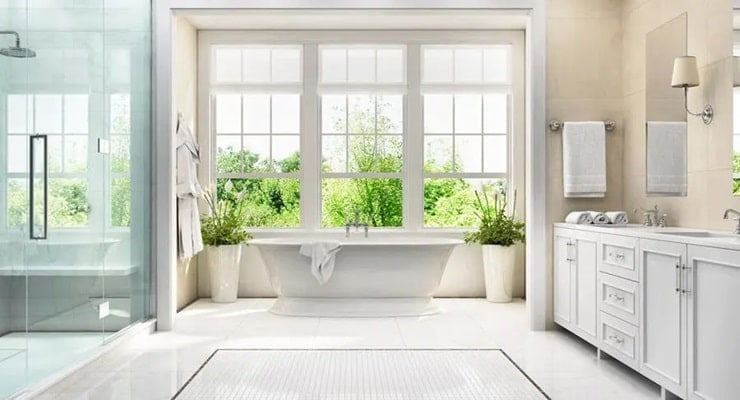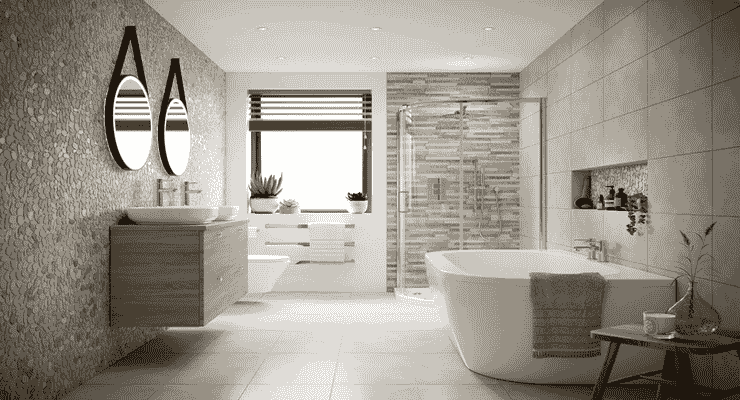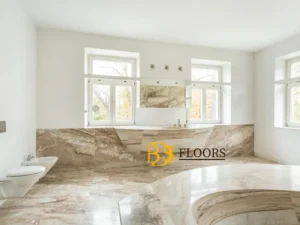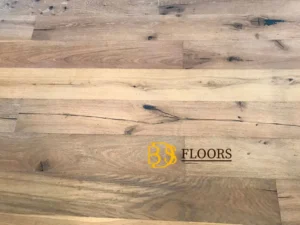Tile Floor For Bathroom: Tips Before Buying Your Next Tile
Are you planning to revamp your bathroom and create a stylish and functional space? One of the most important decisions you’ll need to make is selecting the perfect tile floor. But with so many options available, it can be overwhelming to choose the right one.
In this ultimate guide to choosing the perfect tiles floor for bathroom, we’ll walk you through everything you need to know. From the latest trends to practical considerations, we’ve got you covered.
We’ll discuss the different types of tiles floor for bathroom, such as ceramic, porcelain, and natural stone, and help you understand their pros and cons. You’ll learn about the various finishes, colors, and patterns available, and how to select the ideal size and shape for your bathroom. We’ll also provide expert tips on maintenance and durability, ensuring your tile floor stands the test of time.
Whether you’re aiming for a modern, minimalist look or a rustic, natural vibe, this guide will help you make an informed decision that suits your style and budget. Get ready to transform your bathroom into a beautiful oasis with the perfect tiles floor for bathroom.

Tiles Floor for Bathroom: Considerations when selecting tiles floor for bathroom
Tiles floor for bathroom is a vital element of your bathroom design, and selecting the right tile floor can make a significant impact on the overall aesthetic and functionality of the space. A well-chosen tile floor can transform your bathroom into a beautiful oasis, enhancing its visual appeal and adding value to your home.
Moreover, bathrooms are high-moisture areas, and the floor is subject to constant exposure to water and humidity. Choosing a tiles floor for bathroom that is durable, water-resistant, and easy to maintain is crucial to ensure its longevity and prevent any potential damage or mold growth.
Considerations When Selecting Tile for Bathroom
Before diving into the different types of Tile floor for bathroom available, it’s important to consider a few factors that will influence your decision-making process. These considerations will help you narrow down your options and choose the tile floor for bathroom that best suits your needs and preferences.
First and foremost, think about the style and ambiance you want to create in your bathroom. Are you aiming for a modern, minimalist look or a rustic, natural vibe? Understanding your desired aesthetic will guide you toward the right tile floor for bathroom options in terms of color, pattern, and material.
Another crucial consideration is your budget. Tiles floor for bathroom comes in a wide range of price points, so it’s important to set a budget and determine how much you’re willing to invest in your bathroom renovation. This will help you prioritize your choices and make informed decisions without breaking the bank.
Additionally, think about the practical aspects of your bathroom. Is it a high-traffic area? Do you have kids or pets? Considering factors such as slip resistance, ease of cleaning, and maintenance requirements will ensure that your chosen tiles floor for bathroom is not only visually appealing but also functional and practical for your specific needs.
Different types of tiles floor for bathroom – ceramic, porcelain, natural stone
When it comes to Tiles floor for a bathroom, there are three primary types to choose from: ceramic, porcelain, and natural stone. Each type has its own unique characteristics, advantages, and disadvantages. Let’s take a closer look at each of them.
Ceramic Tiles Floor for Bathroom
Ceramic tiles are a popular choice for bathroom floors due to their versatility, affordability, and wide range of design options. These tiles are made from a mixture of clay and other natural materials, which are then fired at high temperatures to create a durable and water-resistant surface.
One of the main advantages of ceramic tiles is their ability to mimic other materials such as wood or natural stone, allowing you to achieve the desired look without the associated maintenance and cost. Ceramic tile floor for bathroom are available in various sizes, shapes, and finishes, making them suitable for different bathroom styles and preferences.
However, it’s important to note that ceramic tiles are more prone to cracking and chipping compared to porcelain or natural stone tiles. Although they are relatively durable, they may not withstand heavy impacts or sharp objects. Additionally, the glaze on ceramic tiles may wear off over time, requiring periodic resealing to maintain their water resistance.
Porcelain Tile Floor for Bathrooms
Porcelain Tiles floor for bathroom are known for their exceptional durability, making them an excellent choice for high-traffic areas like bathrooms. These tiles are made from a dense and fine-grained clay that is fired at extremely high temperatures, resulting in a hard and non-porous surface.
One of the main benefits of porcelain tiles is their water resistance. The non-porous nature of porcelain prevents water absorption, making it highly resistant to stains, mold, and mildew. This feature is particularly advantageous in bathrooms where moisture is a constant concern.
Porcelain tiles come in a wide range of colors, finishes, and patterns, allowing you to achieve various looks and styles. From sleek and modern to classic and timeless, there is a porcelain tile that suits every bathroom aesthetic.
However, porcelain Tile floor for a bathroom are generally more expensive than ceramic tiles due to their superior durability and manufacturing process. They can also be more challenging to install due to their density and weight. Professional installation is recommended to ensure proper adhesion and alignment.
Natural Stone Tiles Flooring for Bathrooms
For those seeking a luxurious and natural look, natural stone tiles are an excellent choice for bathroom flooring. Natural stone options such as marble, granite, limestone, and travertine offer unique patterns, textures, and colors that cannot be replicated by any other material.
One of the main advantages of natural stone tiles is their timeless beauty and durability. These tile floor for bathroom can withstand heavy foot traffic and are highly resistant to scratches and stains when properly sealed and maintained. They also add a touch of elegance and sophistication to any bathroom design.
However, it’s important to note that natural stone tiles require more maintenance compared to ceramic or porcelain tiles. They are porous and can absorb liquids, making them susceptible to stains and damage if not properly sealed. Regular sealing and cleaning are essential to ensure their longevity and preserve their natural beauty.
Factors to Consider When Choosing the Color and Pattern of Tiles Flooring for Bathrooms

The color and pattern of your tile floor for bathroom play a significant role in creating the desired ambiance and aesthetic. Here are a few factors to consider when making your selection:
1. Size and Layout of the Bathroom: The size of the bathroom will influence the choice of color and pattern. Light-colored tile floor for bathroom can make small bathrooms appear more spacious, while darker tile floor for bathroom can add depth and warmth to larger bathrooms. Additionally, the layout of the bathroom, such as the presence of windows or architectural features, should be taken into account when selecting the color and pattern.
2. Overall Style and Theme: Consider the overall style and theme of your bathroom. If you’re going for a contemporary look, opt for clean lines and neutral colors. For a rustic or traditional vibe, natural stone or textured tiles in earthy tones can create a warm and inviting atmosphere. The color and pattern should complement the other elements in the bathroom, such as the wall color, fixtures, and accessories.
3. Personal Preference: Ultimately, your personal preference should guide your choice of color and pattern. Choose a tile that resonates with your taste and reflects your personality. Don’t be afraid to experiment with bold colors or intricate patterns if that’s what you love. After all, your bathroom should be a reflection of your style and individuality.
Choosing the Right Size and Shape of Tile floor for bathroom
The size and shape of the Tile for Bathroom you choose for your bathroom floor can have a significant impact on the overall look and feel of the space. Here are a few factors to consider when selecting the size and shape:
- Bathroom Size: The size of your bathroom will influence the choice of tile size. For smaller bathrooms, smaller tiles can create a visually pleasing and proportionate look. Larger tiles, on the other hand, can make larger bathrooms appear more spacious and cohesive.
- Style and Design: Consider the overall style and design of your bathroom. If you’re aiming for a modern and contemporary look, large-format tiles with clean lines and minimal grout lines can create a sleek and seamless appearance. For a more traditional or vintage vibe, smaller tiles with intricate patterns or mosaics can add charm and character.
- Practicality and Maintenance: Think about the practical aspects of your chosen tile size and shape. Smaller tiles typically have more grout lines, which can be more challenging to clean and maintain. Larger tiles, on the other hand, may require more precise installation and can be more difficult to cut and handle.
Maintenance and Care Tips for Tile Floor Bathrooms
Proper maintenance and care are essential to ensure the longevity and beauty of your bathroom tile floor. Here are a few tips to keep in mind:
- Regular Cleaning: Sweep or vacuum your tile for bathroom regularly to remove any dirt or debris. Use a mild detergent and warm water solution to mop the floor, being careful not to use abrasive cleaners that can damage the tiles floor for bathroom or grout. Avoid using excessive water, as it can seep into the grout lines and cause damage.
- Sealing: Depending on the type of tile floor for bathroom you choose, sealing may be necessary to protect the surface from stains and moisture penetration. Consult with your tile manufacturer or installer to determine whether sealing is required and how often it should be done.
- Grout Maintenance: Grout lines can accumulate dirt and grime over time, making them appear discolored or dull. Regularly clean the grout lines using a mild grout cleaner and a soft brush. Consider resealing the grout periodically to maintain its appearance and prevent water penetration.
- Preventing Damage: Avoid using harsh chemicals or abrasive tools that can scratch or damage the tiles. Use mats or rugs in high-traffic areas to protect the floor from excessive wear. Promptly clean up any spills or stains to prevent them from penetrating the tile or grout.Read more at BDS Floors
Pros and cons of ceramic tile floor for bathroom
When it comes to selecting tile floor for bathroom, there are three main types to consider: ceramic, porcelain, and natural stone. Each type has its own unique characteristics and benefits, so let’s dive into the pros and cons of each.
Pros and Cons of Ceramic Tile Floor for Bathroom
Ceramic tiles floor for bathroom are a popular choice for bathroom floors due to their affordability, versatility, and durability. They come in various sizes, colors, and patterns, making it easy to find the perfect fit for your bathroom design. Ceramic tiles are also resistant to water and moisture, which is essential for a bathroom environment.
However, one drawback of ceramic tiles is that they can be prone to cracking if not properly installed. Additionally, the grout lines between ceramic tiles can be a breeding ground for mold and mildew if not properly maintained. Regular cleaning and sealing of the grout are necessary to prevent this issue.
Pros and Cons of Porcelain Tile Floor for Bathroom
Porcelain tiles are known for their strength, durability, and low maintenance requirements. They are denser than ceramic tiles, making them highly resistant to water absorption and stains. This makes porcelain tiles an excellent choice for bathrooms, where water exposure is common.
Porcelain tile floor for bathroom are available in a wide range of styles, including designs that mimic natural stone or wood. They can also be installed with minimal grout lines, creating a sleek and seamless look. However, porcelain tiles are generally more expensive than ceramic tiles, which is an important factor to consider when working within a budget.
Pros and Cons of Natural Stone Tiles Floor for Bathroom
For a luxurious and timeless look, natural stone tile floor for bathroom are a popular choice. Options like marble, granite, and slate can add a touch of elegance to any bathroom. Natural stone tiles floor for bathroom are available in various colors and patterns, each with its own unique characteristics.
One advantage of natural stone tiles is their durability, as they can withstand heavy foot traffic and are resistant to scratches. However, they require regular sealing to maintain their appearance and prevent staining. Natural stone tile for bathroom floor can also be more expensive than ceramic or porcelain tiles, so budget-conscious individuals may need to consider this factor.Read more at BDS Floors

Pros and cons of porcelain tile floor for bathrooms
The color and pattern of your bathroom tile for bathroom play a crucial role in setting the overall mood and style of the space. Here are some factors to consider when making your selection:
- Size of the Bathroom
- The size of your bathroom can influence the choice of color and pattern for the Tile floor for bathroom. Light-colored tile floor for bathroom can make a small bathroom appear more spacious and airy, while dark-colored tiles can add drama and sophistication to a larger bathroom.
- Style and Theme. Consider the overall style and theme of your bathroom when choosing the color and pattern of the tile flooring. For a modern and minimalist look, neutral colors and simple patterns are often preferred. On the other hand, if you’re going for a rustic or natural vibe, earth tones and textured patterns can create a warm and inviting atmosphere.
- Lighting
Read more at BDS Floors
Pros and cons of natural stone tile floor for bathrooms
The size and shape of the tiles can greatly impact the overall aesthetic of your bathroom. Here are some tips to help you make the right choice:
- Consider the Size of the Bathroom.
In a small bathroom, larger tile floor for bathroom can create the illusion of a larger space by reducing the number of grout lines. On the other hand, in a larger bathroom, smaller tiles can add visual interest and create a unique look. - Balance and Proportion.
Consider the size of the fixtures and fittings in your bathroom when choosing the size and shape of the tiles. Aim for a balanced and proportionate look by selecting tiles that complement the overall size and layout of the space. - Tile Flooring for Bathroom Layout
The way you lay the tiles floor for bathroom can also have an impact on the overall aesthetic. Consider different tile layout patterns, such as herringbone, basketweave, or subway, to add visual interest and create a unique design.
Factors to consider when choosing the color and pattern of tile floor for bathroom
Proper maintenance and care are essential to ensure the longevity and beauty of your bathroom tile flooring. Here are some tips to keep your tile in top condition:
- Regular Cleaning for Tile floor for bathroom.
Regularly clean your tile flooring using a mild detergent and warm water. Avoid using harsh chemicals or abrasive cleaners that can damage the tile. Be sure to remove any spills or stains promptly to prevent them from becoming permanent. - Grout Maintenance.
Regularly inspect the grout lines between the tiles and clean them as needed. Use a grout cleaner and a brush to remove any dirt or grime. Additionally, consider sealing the grout lines to prevent staining and minimize the growth of mold and mildew. - Preventive Measures
To protect your tile floor for bathroom, use mats or rugs in high-traffic areas to minimize wear and tear. Avoid dragging heavy objects across the tiles, as this can cause scratches or cracks. Lastly, be cautious when using certain cleaning tools or chemicals that may damage the tiles or grout.Read more at BDS Floors
Tiles Floor For Bathroom: Choosing the right size and shape

Choosing the perfect tile floor for bathroom for your bathroom is a decision that requires careful consideration. By understanding the different types of tiles, considering factors like color and pattern, selecting the right size and shape, and implementing proper maintenance and care, you can create a beautiful and functional bathroom that suits your style and budget.
Transform your bathroom into a stunning oasis with the perfect tile floor. From ceramic and porcelain to natural stone, the options are endless. Embrace your creativity and create a bathroom that reflects your taste and enhances your daily routine. With the ultimate guide to choosing the perfect tile floor for your bathroom, you’ll be well-equipped to make an informed decision and achieve the bathroom of your dreams.
Tile Floor For Bathroom: Choosing the right size and shape
Choosing the perfect tile floor for bathroom is a decision that requires careful consideration. By understanding the different types of tiles, considering factors like color and pattern, selecting the right size and shape, and implementing proper maintenance and care, you can create a beautiful and functional bathroom that suits your style and budget.
Transform your bathroom into a stunning oasis with the perfect Tile floor for bathroom. From ceramic and porcelain to natural stone, the options are endless. Embrace your creativity and create a bathroom that reflects your personal taste and enhances your daily routine. With the ultimate guide to choosing the perfect tile floor for your bathroom, you’ll be well-equipped to make an informed decision and achieve the bathroom of your dreams. Read more at BDS Floors
Conclusion: Make the right choice for your tiles
The size and shape of tile floor for bathroom you choose for your bathroom can have a significant impact on the overall appearance and functionality of the space. Here are some factors to consider when selecting the right size and shape of tiles.
1. Bathroom Layout and Size
Consider the layout and size of your bathroom when choosing tile sizes and shapes of the tile floor for bathroom. Larger tiles can make a small bathroom feel more spacious, as there are fewer grout lines to visually break up the space. On the other hand, smaller tile floor for bathroom can be ideal for creating intricate patterns or adding visual interest to larger bathrooms.
2. Grout Lines
The size and shape of tile floor for bathroom will determine the number and visibility of grout lines. If you prefer a seamless and uniform look, larger tiles with minimal grout lines are the way to go. However, keep in mind that larger tiles may require more precise installation to ensure a level and even surface.
3. Safety and Slip Resistance
Read more at BDS Floors








